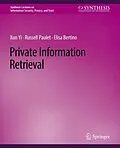This book deals with Private Information Retrieval (PIR), a technique allowing a user to retrieve an element from a server in possession of a database without revealing to the server which element is retrieved. PIR has been widely applied to protect the privacy of the user in querying a service provider on the Internet. For example, by PIR, one can query a location-based service provider about the nearest car park without revealing his location to the server. The first PIR approach was introduced by Chor, Goldreich, Kushilevitz and Sudan in 1995 in a multi-server setting, where the user retrieves information from multiple database servers, each of which has a copy of the same database. To ensure user privacy in the multi-server setting, the servers must be trusted not to collude. In 1997, Kushilevitz and Ostrovsky constructed the first single-database PIR. Since then, many efficient PIR solutions have been discovered. Beginning with a thorough survey of single-database PIR techniques, this text focuses on the latest technologies and applications in the field of PIR. The main categories are illustrated with recently proposed PIR-based solutions by the authors. Because of the latest treatment of the topic, this text will be highly beneficial to researchers and industry professionals in information security and privacy.
Autorentext
Xun Yi is a professor with the College of Engineering and Science, Victoria University, Australia. His research interests include applied cryptography, computer and network security, mobile and wireless communication security, and privacy-preserving data mining. He has published more than 100 research papers in international journals, such as IEEE Trans. Knowledge and Data Engineering, IEEE Trans. Wireless Communication, IEEE Trans. Dependable and Secure Computing, IEEE Trans. Circuit and Systems, IEEE Trans. Vehicular Technologies, IEEE Communication Letters, IEE Electronic Letters, and conference proceedings. He has undertaken program committee members for more than 20 international conferences. He is leading a few of Australia Research Council (ARC) Discovery Projects.
